“They’d’ve replaced his whole body if it would’ve improved performance. If that’s how you judge a man — by performance — then eventually it’s not about people but upgrades, versions, functionality…”

Annotated Walkthrough, 1:
Several things are apparently from the moment you arrive on Liberty Island. The headless Statue Of Liberty is the most obvious element, the symbolism heavy handed but effective. Less obvious but just as unsettling if noticed is the lack of the twin towers of the World Trade Centre in the New York skyline. Supposedly destroyed by terrorists some years prior to the events of Deus Ex, they actually fell victim to a lack of memory and the skyline texture that included them never made it into the map. Ominously prescient for a game released in the summer of 2000.
Though maybe not as obvious as some of the more symbolic elements on display is the fact that this is Liberty Island. It might not be a completely accurate recreation, however it is close enough to feel like a real place. If you haven’t visited the island itself, or even if you have, the representation is close enough to convey the essence of the place. This is not a space station or underwater city, it is a place that looks decided mundane by comparison, a place that feels like it actually exists. This sensation of reality, or something close to it, is one that is common to numerous locations throughout Deus Ex.
You start your time on Liberty Island with very little information and what little you have obtained by the end is tainted with the ambiguity that surrounds the actions of the supposed ‘terrorists’ and your own allies. The initial cutscene introduction is vague to the point of being intentionally obscure; which it undoubtable is. The general tone of a world on the edge of collapse is evident even if the organisations involved and their motivations are still unclear.
Find Paul.” Locating your brother is your first goal on Liberty Island though completion of this task requires little effort on your part as once you move forward from your starting position Paul will head directly for you and initiate conversation. NPCs that come to find you instead of standing in one spot waiting are still uncommon in games, though Deus Ex has it’s fair share of static NPCs too.
There is a fair bit of information provided in this first conversation, though some of it is presented in a much more subtle fashion that a traditional “Here are your objectives…” information dump. Some of the key points of narrative information provided by your brother are that JC is actually your codename, and that UNATCO are technically classified as a police force. In additional to this contextual information Paul also provides some clarification on the underlying dynamics of Deus Ex, specifically that non-lethal take-downs are always more silent that lethal take-downs, though this is only one of several differences between the two methods of “eliminating resistance” it is the most immediately useful.
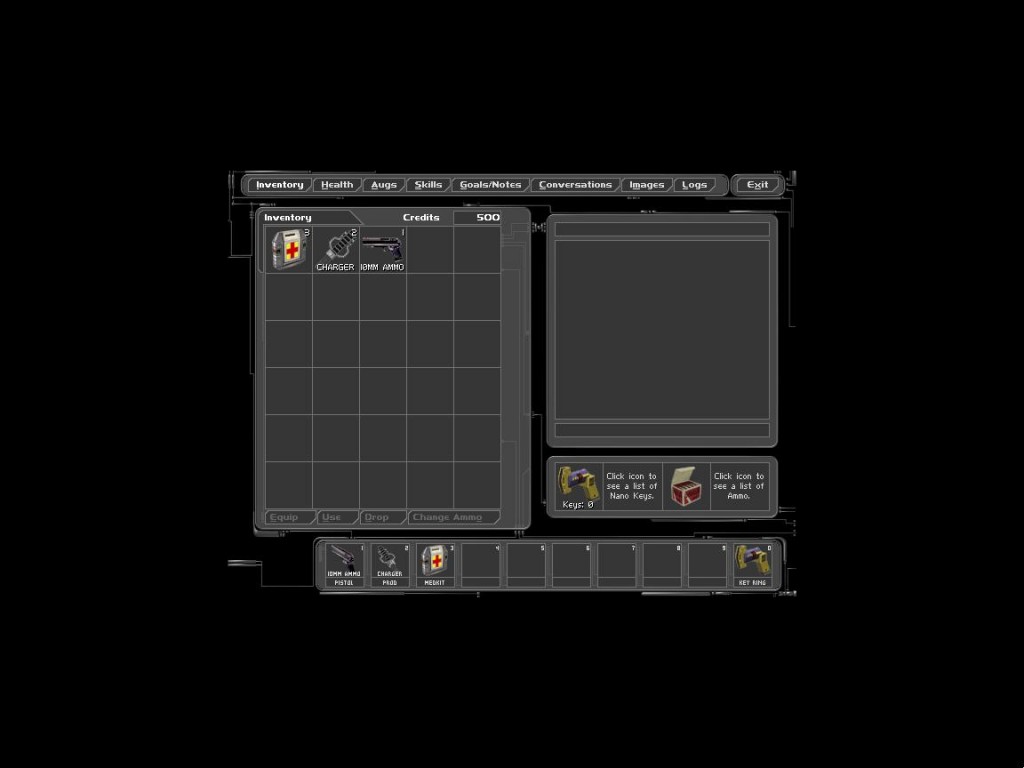
After this brief, but surprisingly information heavy, introduction Paul provides you with a choice of which additional weapon you want. Already equipped with an Electric Prod and a Pistol the weapons on offer are a Sniper Rifle, a Mini-Crossbow and a GEP Gun. Of these weapons, the first two are actually retrievable within the level itself and the last, the GEP Gun, is actually one of the most powerful weapons in the game, and if not collected here it will be several hours before you next have the opportunity to acquire it.
Given his previous reminder that UNATCO are a law enforcement force, it’s interesting that Paul saves his most severe criticism for the choice of the Sniper Rifle. Though he never explicitly condemns your weapon selection he is clearly less happy with your selection of the Sniper Rifle than even the GEP Gun. Asking for the GEP Gun leads to Paul providing you with additional information regarding the presence of a Security Bot outside the statue entrance.
Your primary objective is to gain access to the NSF command centre at the top of the statue, though your are reminded “don’t forget about Agent Hermann.” The off hand manner in which his fate is discussed give some clue as to Paul’s own attitude regarding UNATCO’s bastion of Teutonic efficiency. If you opted to play through the Training level you will have a little background information regarding the NSF and how they believe they are fighting “the Second American Revolution”. Little information is provided beyond that and it won’t be until you reach UNATCO Headquarters in the next level that you find out what NSF stands for: National Secessionist Forces. You are told they are ‘terrorists’ and that’s all you should need to know.
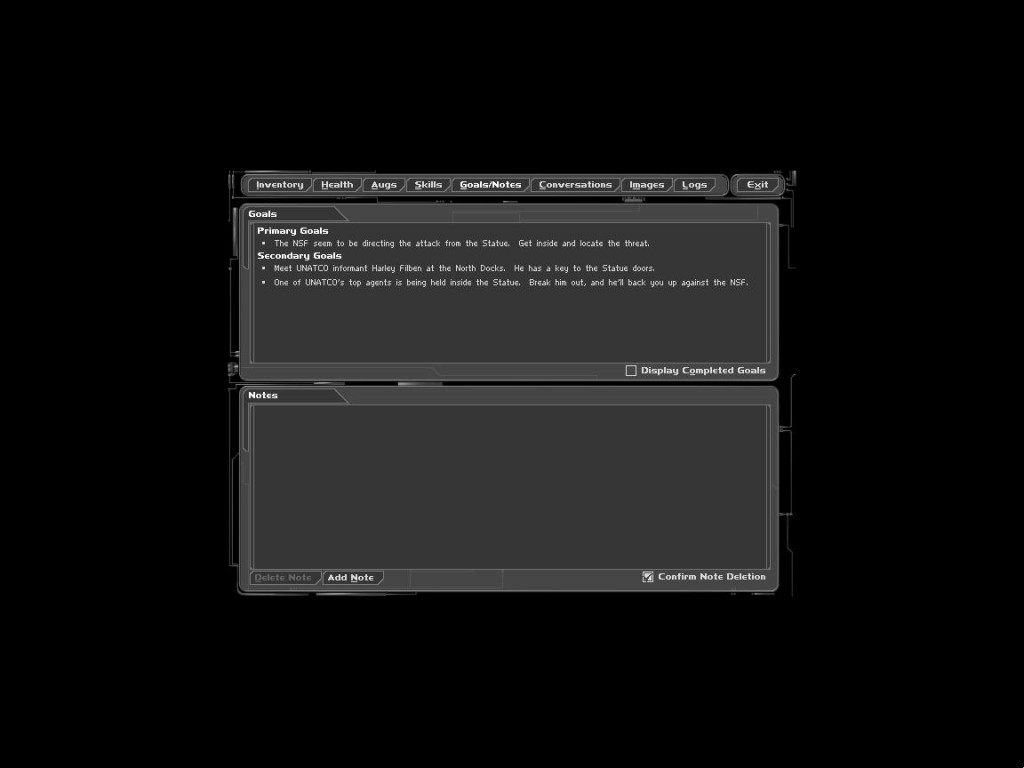
Complete with an additional weapon, a map of the island and your objectives it’s now time to get on with the task at hand. I have to wonder what the motivation was for allowing you to select your additional weapon before finding out exactly what your objectives are for the mission? You also have the option to upgrade some of your skills at the start of the game it is possible to not spend those skill points until a later stage (there is little feedback to indicate this is a possibility however), contrarily there is no such option to delay your choice of an additional weapon. The implication is that skill choices are permanent and should be deliberated on, while weapon selection takes place on a far more ad-hoc basis.
Though Paul begins to walk away at this point it is possible to engage him in conversation twice more. Of little direct use to your current objectives the information provided in these subsequent conversations does become progressively more personal, eventually heavily implying that Paul and JC are now orphans though the reasons for this are left unspecified.
Looking around the immediate area is somewhat spartan, which is not surprising for a game from 2000, however with few exceptions all the objects within view can be interacted with in some manner. With the exception of container Crates, objects that are specifically useable will be placed in your inventory upon use, all other objects appear ‘in your hands’; floating transparently in front of you. Simulated physics and AI agents able to react to sight and sound cues mean that even these apparently functionless objects can be used as navigation aids or thrown as a means of distraction. Objects can also be dropped into the water with some (Garbage Bag) floating while others (Crowbar) will sink. This fidelity of simulation though fairly rudimentary in absolute terms can lead to some creative solutions to otherwise challenging problems.
To the right of your starting position there are two Crates, along with a Crowbar to open them. A Crowbar is an object with strong affordances (There is an ingrained understanding that Crowbars are used for prying something open) making it a sensible object to leave near Crates, it’s placement serves both a functional and narrative purpose. The former purpose could be fulfilled by any other melee weapon in the game such as a Combat Knife, though the associations between a Combat Knife and a Crate are not as strong as those between a Crowbar and a Crate; if it had been a Cardboard Crate the associations would be reversed somewhat. Since all that results from using the Crowbar on the Crate is that the Crate is smashed functionally it could have been any melee weapon placed near the Crates to allow the player to open them, the Crowbar not only satisfied this need but also simply looks more appropriate. It serves a dual function, providing a required tool for the player while also helping to imply a consistency to the world, somebody put the Crowbar there to open those Crates.
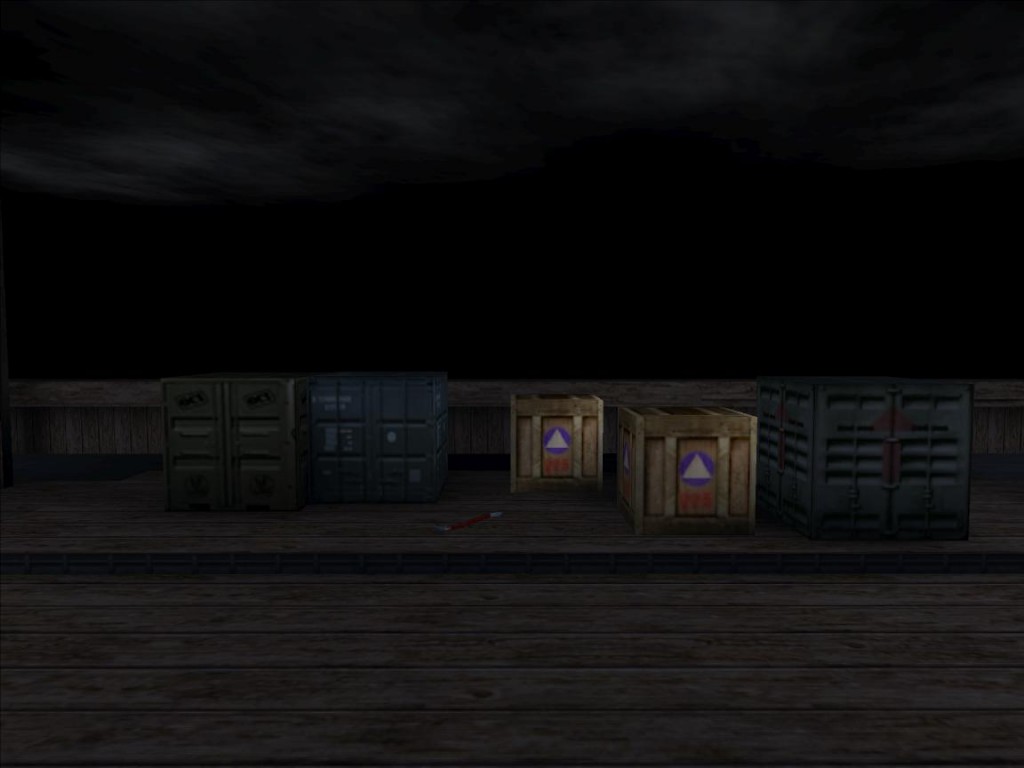
Inside these Crates are a set of Bionoculars and a Lockpick, the function of the latter you will have been taught in the tutorial (If you opted to play through it), use of former is not explicitly explained but much like the Crowbar it has a strong affordance.
On the opposite side of the dock there’s access to the water, and a small cage containing two more Crates. Inside these are a Multitool, again something whose function has been taught to you previously, and a Bioelectric Cell. The purpose of these Cells has been referenced in the tutorial though they have not been seen previously. Since it is extremely unlikely any will be needed at this stage it can get away with not been as clear to identify as all the other objects so far have been. That said I do wonder why it’s design wasn’t made even closer to that of a traditional battery?
After an all but unavoidable conversation with UNATCO Trooper Corporal Collins, providing a slightly different perspective on the events that led to Agent Hermann’s capture it’s time to head into the level proper.
To the left of the ramp leading onto the island there is a collection of three Crates each containing a different type of ammunition for a weapon you either currently have (10mm Ammo, and Prod Charger), along with an alternate ammunition type for a weapon you may have been given by Paul (Darts). At this time Alex Jacobsen returns to remind you of UNATCOs order to “shoot on sight” which is a markedly different approach to that advised by Paul only moments earlier. Even at this very early stage of the game the divisions between UNATO’s stated policy (As espoused by Paul Denton) and the practical application of that policy (As shown by your orders) are beginning to show.
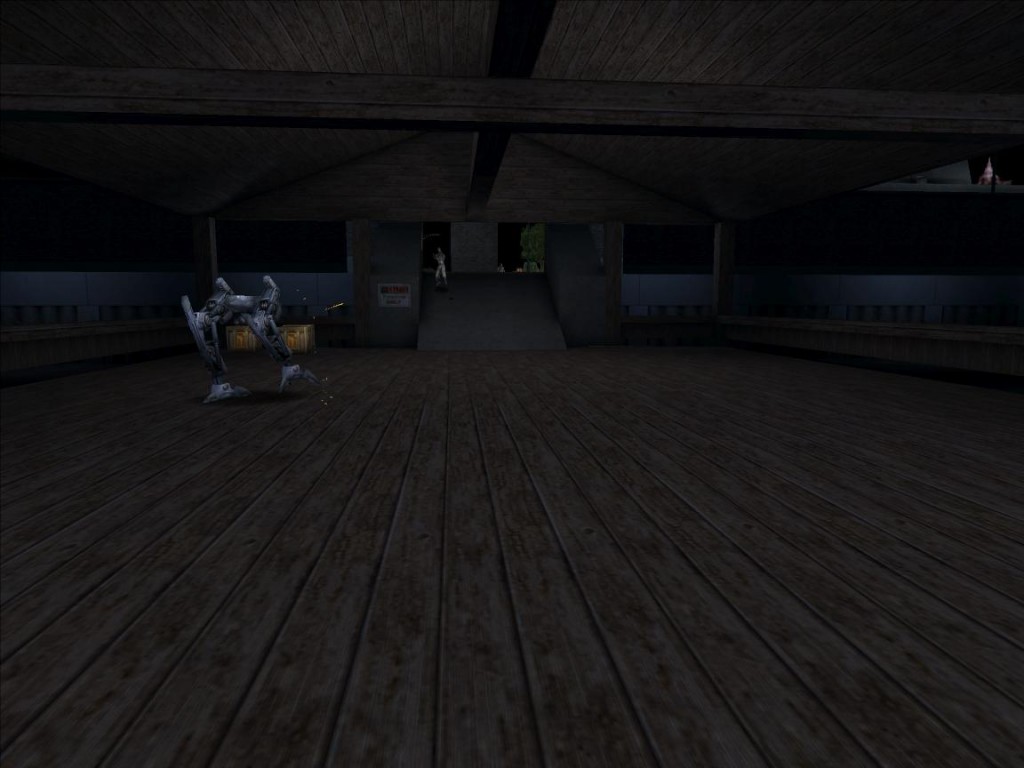
Until this point you have been relatively isolated from the rest of the level, relatively because as is the nature of Deus Ex, occasionally things happen that are potentially unexpected. The patrolling Security Bot on the South Dock appears to be there just to reinforce that this dock is safe territory, however it is possible for one of the roaming NSF Terrorists on the island to become alerted to activity on the South Dock and approach, at which point a fight will break out between them and the Security Bot. There is no strict demarcation of territory or encounters on Liberty Island and very little to stop you from actively exploiting that to pull the NSF Terrorists in the first part of the island down onto the South Dock where they will be dealt with by the Security Bot. This type of non-scripted behaviour is common in Deus Ex and exploring Liberty Island you begin to see why that is the case; with few strict barriers between different encounters it is possible for events in one to directly influence another. This is an encounter design philosophy that can cause unpredictable behaviour and as such is one that is becoming increasingly uncommon in recent games. Consider the strictly demarcated encounters in Splinter Cell: Conviction where it is next to impossible for enemies from one location to wander into another. This makes each encounter an isolated incident that can be handled on it’s own terms, and clearly helps when it comes to the design and testing of such encounters. Yet this isolation can itself serve to reinforce the artificiality of such strictly partitioned encounter spaces.
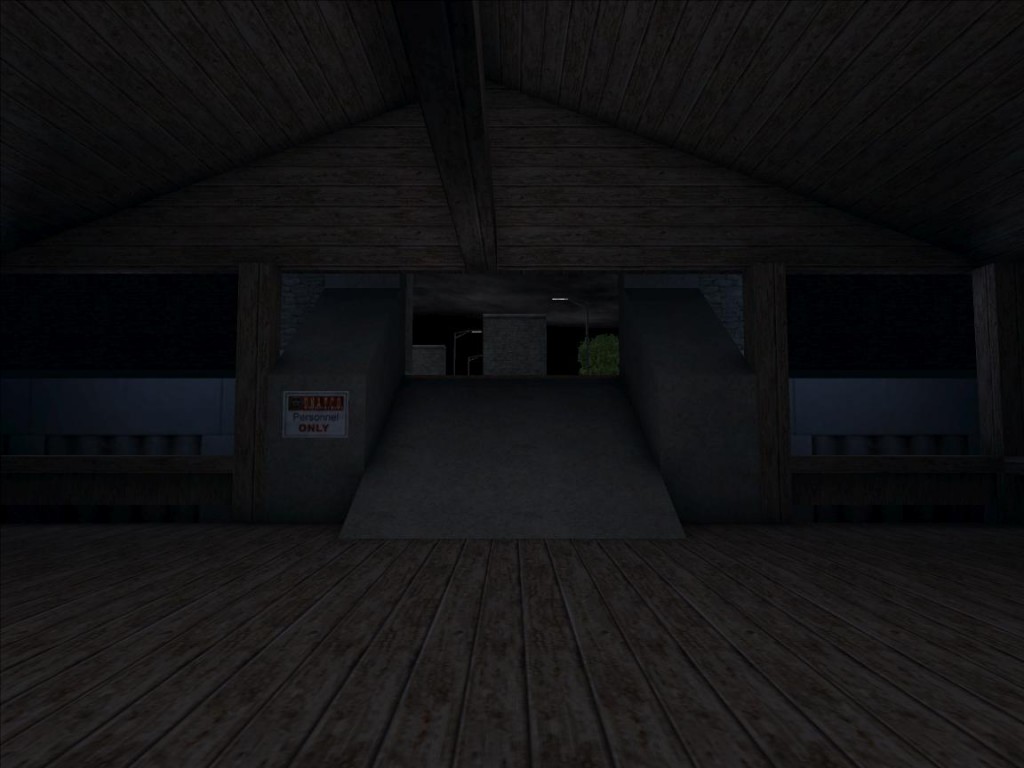
It’s time to leave the South Dock and move onto Liberty Island where the game begins to show it’s subtle complexity very quickly.